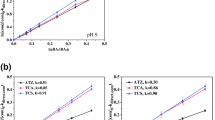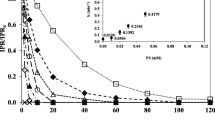Abstract
This study aimed to investigate the degradability, mineralization, proposed decomposition pathway, intermediate products, and toxicity of effluent from trichlorfon (TCF) degradation in water by UV/sulfite-advanced reduction process (UV/S-ARP). This study was experimentally performed in a photochemical reactor as a batch operation. The source of light was a UV lamp. Sulfite ion was used as the reducing agent. After the treatment, the residual concentration of TCF was measured by liquid chromatography equipped with tandem mass spectrometry (LC–MS/MS). UV/S-ARP had the highest performance at an initial pH of 7, a sulfite ion concentration of 120 mg/L, a contact time of 60 min, and a TCF concentration of 10 mg/L. Under such conditions, the degradation efficiency of TCF was 96.0%, and the amount of mineralization based on the removal of TOC and COD was 74.6% and 79.5%, respectively. The results of the degradation mechanism showed that eaq− and SO3•− have played the greatest role in dechlorination and transformation of TCF. Based on the identified intermediates, more complex compounds are transformed into compounds with simpler structures by UV/S-ARP. Evaluating the toxicity of TCF by-products via ECOSAR bioassay showed that as-generated intermediates do not have acute and chronic adverse effects on fish. The results of our study indicated that the advanced reduction process could be an effective process for the purification of TCF-contaminated water.











Similar content being viewed by others
Data availability
The data used and/or analyzed is available on requests from the corresponding author by emailing to h.godini@absuma.ac.ir
References
APHA (2017) Standard methods for the examination of water and wastewater. In: Baird RB (ed) Water Environment Federation, 23rd edn. American Public Health Association, American Water Works Association
Botlaguduru VSV, Batchelor B, Abdel-Wahab A (2015) Application of UV–sulfite advanced reduction process to bromate removal. J Water Process Eng 5:76–82
Cao Y, Qiu W, Li J, Jiang J, Pang S (2020) Review on UV/sulfite process for water and wastewater treatments in the presence or absence of O2. Science of The Total Environment:142762
Chen J, Xu X, Pan X, Yao J, Li C, Qu R, Wang Z (2018a) Mechanism insights into the oxidative degradation of decabromodiphenyl ethane by potassium permanganate in acidic conditions. Chem Eng J 332:267–276
Chen J, Xu X, Zeng X, Feng M, Qu R, Wang Z, Nesnas N, Sharma VK (2018b) Ferrate (VI) oxidation of polychlorinated diphenyl sulfides: kinetics, degradation, and oxidized products. Water Res 143:1–9
Cheng X, Li L, Zhao Y, Ca W (2016) Absorption and emission spectroscopic characteristics of dipterex and its molecularly imprinted recognition: a TD-DFT investigation. Chem Phys Lett 652:93–97
Claeys L, Iaccino F, Janssen CR, Van Sprang P, Verdonck F (2013) Development and validation of a quantitative structure–activity relationship for chronic narcosis to fish. Environ Toxicol Chem 32(10):2217–2225
Dan Z (2012) Study on the treatment of trichlorfon wastewater with activated carbon [J]. Journal of Anhui Agricultural Sciences 1
Dunier M, Siwicki AK, Demaël A (1991) Effects of organophosphorus insecticides: effects of trichlorfon and dichlorvos on the immune response of carp (Cyprinus carpio). Ecotoxicol Environ Saf 22(1):79–87
Entezari M, Godini H, Sheikhmohammadi A, Esrafili A (2019) Enhanced degradation of polychlorinated biphenyls with simultaneous usage of reductive and oxidative agents over UV/sulfite/TiO2 process as a new approach of advanced oxidation/reduction processes. J Water Process Eng 32:100983
Eraslan G, Kanbur M, Silici S, Karabacak M (2010) Beneficial effect of pine honey on trichlorfon induced some biochemical alterations in mice. Ecotoxicol Environ Saf 73(5):1084–1091
Gu J, Ma J, Jiang J, Yang L, Yang J, Zhang J, Chi H, Song Y, Sun S, Tian WQ (2017) Hydrated electron (eaq−) generation from phenol/UV: efficiency, influencing factors, and mechanism. Appl Catal B 200:585–593
Guimarães ATB, Silva de Assis HC, Boeger W (2007) The effect of trichlorfon on acetylcholinesterase activity and histopathology of cultivated fish Oreochromis niloticus. Ecotoxicol Environ Saf 68(1):57–62
Guo G, Li B, Huang H, Zhao N, Li J, Liu Y, Lv X, Zhang M, Cao L, Tai Z (2020) Radical-based advanced oxidation for trichlorfon degradation and phosphorus recovery: process feasibility and reaction mechanism. J Clean Prod 275:122706
Hirun-Utok C, Phattarapattamawong S (2019) Degradation and transformation of natural organic matter accountable for disinfection byproduct formations by UV photolysis and UV/chlor (am) ine. Water Sci Technol 79(5):929–937
Hofman-Caris C, Harmsen D, Wols B (2021) UV/Sulphite as alternative for UV/H2O2 for micropollutant degradation in drinking water. Water Supply
Ismail S, Tawfik A (2016) Performance of passive aerated immobilized biomass reactor coupled with Fenton process for treatment of landfill leachate. Int Biodeterior Biodegradation 111:22–30
Jung B, Farzaneh H, Khodary A, Abdel-Wahab A (2015) Photochemical degradation of trichloroethylene by sulfite-mediated UV irradiation. J Environ Chem Eng 3(3):2194–2202
Jung B, Nicola R, Batchelor B, Abdel-Wahab A (2014) Effect of low-and medium-pressure Hg UV irradiation on bromate removal in advanced reduction process. Chemosphere 117:663–672
Li C, Yuan S, Jiang F, Xie Y, Guo Y, Hang Y, Cheng Y, Qian H, Yao W (2020) Degradation of fluopyram in water under ozone enhanced microbubbles: kinetics, degradation products, reaction mechanism, and toxicity evaluation. Chemosphere:127216
Li C, Zhu H, Guo Y, Xie Y, Cheng Y, Yu H, Qian H, Yao W (2020) Investigation of the transformation and toxicity of trichlorfon at the molecular level during enzymic hydrolysis of apple juice. Food Chemistry:128653
Li W, Ma Y, Li L, Qin D-M, Wu Y-J (2011) The dissipation rates of trichlorfon and its degradation product dichlorvos in cabbage and soil. Chemosphere 82(6):829–833
Li X, Ma J, Liu G, Fang J, Yue S, Guan Y, Chen L, Liu X (2012) Efficient reductive dechlorination of monochloroacetic acid by sulfite/UV process. Environ Sci Technol 46(13):7342–7349
Li Y, Gao Q, Xing T, Wang D, Zhang W, Wang Q (2016) Sorption and photocatalytic degradation of trichlorfon by foam concrete blended with nitrogen-doped titanium dioxide. J Mater Civ Eng 28(5):04015200
Liu H, Chen J, Wu N, Xu X, Qi Y, Jiang L, Wang X, Wang Z (2019) Oxidative degradation of chlorpyrifos using ferrate (VI): kinetics and reaction mechanism. Ecotoxicol Environ Saf 170:259–266
Liu S, Fu Y, Wang G, Liu Y (2021) Degradation of sulfamethoxazole by UV/sulfite in presence of oxygen: efficiency, influence factors and mechanism. Sep Purif Technol 268:118709
Liu X, Vellanki BP, Batchelor B, Abdel-Wahab A (2014) Degradation of 1, 2-dichloroethane with advanced reduction processes (ARPs): effects of process variables and mechanisms. Chem Eng J 237:300–307
Liu X, Yoon S, Batchelor B, Abdel-Wahab A (2013a) Degradation of vinyl chloride (VC) by the sulfite/UV advanced reduction process (ARP): effects of process variables and a kinetic model. Sci Total Environ 454:578–583
Liu X, Yoon S, Batchelor B, Abdel-Wahab A (2013b) Photochemical degradation of vinyl chloride with an advanced reduction process (ARP)—effects of reagents and pH. Chem Eng J 215–216:868–875
Ma Y, Li B, Ke Y, Zhang Y (2018) Effects of low doses Trichlorfon exposure on Rana chensinensistad poles. Environ Toxicol 34(1):30–36
Mayo-Bean K, Moran-Bruce K, Nabholz J, Meylan W, Howard P, Cassidy L (2012) Operation manual for the Ecological Structure-Activity Relationship Model (ECOSAR) class program. Risk Assessment Division, US EPA
Nyangiwe N, Baatjie B, Greyling C, Khenfouch M, Maaza M (2018) The decolourisation of methyl orange and textile effluent under UV using commercial and synthesized nano-TiO2. JPhCS 984(1):012009
Rani M, Shanker U (2017) Degradation of traditional and new emerging pesticides in water by nanomaterials: recent trends and future recommendations. Int J Environ Sci Technol 15(6):1347–1380
Sepyani F, Soltani RDC, Jorfi S, Godini H, Safari M (2018) Implementation of continuously electro-generated Fe3O4 nanoparticles for activation of persulfate to decompose amoxicillin antibiotic in aquatic media: UV254 and ultrasound intensification. J Environ Manage 224:315–326
Talebpour Z, Ghassempour A, Zendehzaban M, Bijanzadeh HR, Mirjalili MH (2006) Monitoring of the insecticide trichlorfon by phosphorus-31 nuclear magnetic resonance (31P NMR) spectroscopy. Anal Chim Acta 576(2):290–296
Tay KS, Madehi N (2015) Ozonation of ofloxacin in water: by-products, degradation pathway and ecotoxicity assessment. Sci Total Environ 520:23–31
Trojanowicz M, Bojanowska-Czajka A, Bartosiewicz I, Kulisa K (2018) Advanced oxidation/reduction processes treatment for aqueous perfluorooctanoate (PFOA) and perfluorooctanesulfonate (PFOS)—a review of recent advances. Chem Eng J 336:170–199
United Nations (2011) Globally harmonized system of classification and labelling of chemicals (GHS). United Nations New York and Geneva, p 568
Vellanki BP, Batchelor B, Abdel-Wahab A (2013) Advanced reduction processes: a new class of treatment processes. Environ Eng Sci 30(5):264–271
Wan L, Wu Y, Ding H, Zhang W (2020) Toxicity, Biodegradation, and metabolic fate of organophosphorus pesticide trichlorfon on the freshwater algae Chlamydomonas reinhardtii. J Agric Food Chem 68(6):1645–1653
Woo SJ, Kim NY, Kim SH, Ahn SJ, Seo JS, Jung SH, Cho MY, Chung JK (2018) Toxicological effects of trichlorfon on hematological and biochemical parameters in Cyprinus carpio L. following thermal stress. Comp Biochem Physiol c: Toxicol Pharmacol 209:18–27
World Health Organization (2020) The WHO recommended classification of pesticides by hazard and guidelines to classification 2019. World Health Organization
Xie B, Li X, Huang X, Xu Z, Zhang W, Pan B (2017a) Enhanced debromination of 4-bromophenol by the UV/sulfite process: efficiency and mechanism. J Environ Sci 54:231–238
Xie B, Shan C, Xu Z, Li X, Zhang X, Chen J, Pan B (2017b) One-step removal of Cr(VI) at alkaline pH by UV/sulfite process: reduction to Cr(III) and in situ Cr(III) precipitation. Chem Eng J 308:791–797
Yazdanbakhsh A, Eslami A, Mahdipour F, Ghanbari F, Ghasemi SM, Atamaleki A, Maleksari HS, Lin K-YA (2020) Dye degradation in aqueous solution by dithionite/UV-C advanced reduction process (ARP): kinetic study, dechlorination, degradation pathway and mechanism. J Photochem Photobiol A Chem 407:112995
Yazdanbakhsh A, Eslami A, Mahdipour F, Ghanbari F, Ghasemi SM, Atamaleki A, Maleksari HS, Lin K-YA (2021) Dye degradation in aqueous solution by dithionite/UV-C advanced reduction process (ARP): kinetic study, dechlorination, degradation pathway and mechanism. J Photochem Photobiol A Chem 407:112995
Yazdanbakhsh A, Eslami A, Moussavi G, Rafiee M, Sheikhmohammadi A (2018) Photo-assisted degradation of 2, 4, 6-trichlorophenol by an advanced reduction process based on sulfite anion radical: degradation, dechlorination and mineralization. Chemosphere 191:156–165
Yu H, Nie E, Xu J, Yan S, Cooper WJ, Song W (2013) Degradation of diclofenac by advanced oxidation and Reduction processes: kinetic studies, degradation pathways and toxicity assessments. Water Res 47(5):1909–1918
Yu X, Cabooter D, Dewil R (2018) Effects of process variables and kinetics on the degradation of 2, 4-dichlorophenol using advanced reduction processes (ARP). J Hazard Mater 357:81–88
Yu X, Cabooter D, Dewil R (2019) Efficiency and mechanism of diclofenac degradation by sulfite/UV advanced reduction processes (ARPs). Sci Total Environ 688:65–74
Yu X, Gocze Z, Cabooter D, Dewil R (2020) Efficient reduction of carbamazepine using UV-activated sulfite: assessment of critical process parameters and elucidation of radicals involved. Chem Eng J 404:126403
Zhang C, Chen Z, Tao Y, Ke T, Li S, Wang P, Chen L (2020) Enhanced removal of trichlorfon and Cd(II) from aqueous solution by magnetically separable chitosan beads immobilized Aspergillus sydowii. Int J Biol Macromol 148:457–465
Zhang M, Zhang Z, Cheng C, Li H, Li X (2018) Solar photocatalytic degradation of trichlorfon wastewater over TiO2. J Southwest For Univ 38(5):161–167
Funding
This research was funded by Alborze University of Medical Sciences (grant number: 1397–03-05–213 and ethics code: IR.ABZUMS.REC.1398.012).
Author information
Authors and Affiliations
Contributions
BJ has performed experiments and written the draft of the manuscript, HG contributed to the design and implementation of the research and has given the idea of the research, RDCS contributed to the design of the study and edited the manuscript, and ES contributed to the implementation of the study and the revision of the paper.
Corresponding author
Ethics declarations
Ethics approval
Not applicable.
Consent to participate
Not applicable.
Consent for publication
Not applicable.
Competing interests
The authors declare no competing interests.
Additional information
Responsible Editor: Ricardo A. Torres-Palma
Publisher's note
Springer Nature remains neutral with regard to jurisdictional claims in published maps and institutional affiliations.
Rights and permissions
About this article
Cite this article
Jafari, B., Godini, H., Soltani, R.D.C. et al. Effectiveness of UV/SO32− advanced reduction process for degradation and mineralization of trichlorfon pesticide in water: identification of intermediates and toxicity assessment. Environ Sci Pollut Res 29, 20409–20420 (2022). https://doi.org/10.1007/s11356-021-17274-z
Received:
Accepted:
Published:
Issue Date:
DOI: https://doi.org/10.1007/s11356-021-17274-z




